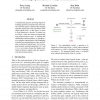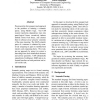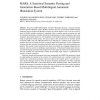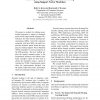ACL
2011
13 years 11 months ago
2011
We describe a new approach to disambiguating semantic frames evoked by lexical predicates previously unseen in a lexicon or annotated data. Our approach makes use of large amounts...
ACL
2011
13 years 11 months ago
2011
Compositional question answering begins by mapping questions to logical forms, but training a semantic parser to perform this mapping typically requires the costly annotation of t...
COLING
2010
14 years 2 months ago
2010
This paper presents a framework for combining semantic relations extracted from text to reveal even more semantics that otherwise would be missed. A set of 26 relations is introdu...
EMNLP
2009
14 years 5 months ago
2009
We present the first unsupervised approach to the problem of learning a semantic parser, using Markov logic. Our USP system transforms dependency trees into quasi-logical forms, r...
ACL
2009
14 years 5 months ago
2009
We present a new approach to learning a semantic parser (a system that maps natural language sentences into logical form). Unlike previous methods, it exploits an existing syntact...
MT
2002
14 years 7 months ago
2002
We present MARS (Multilingual Automatic tRanslation System), a research prototype speech-to-speech translation system. MARS is aimed at two-way conversational spoken language trans...
NAACL
2007
14 years 8 months ago
2007
We present a method for utilizing unannotated sentences to improve a semantic parser which maps natural language (NL) sentences into their formal meaning representations (MRs). Gi...




